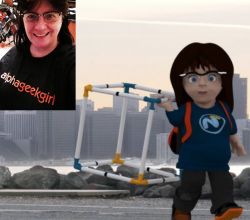Step-by-Step
The 'step-by-step' section is a collection of MODO workflows whichl achieve a particular outcome. Some of them you may not have done for a while, so they're here just to jog your memory so you know what step comes next :)
Creating Custom Sliders for Morph maps
| Description | Once you've created a variety of morphs for your character's facial expressions, creating "sliders" by using the channel haul tool and custom user-channels, will enable you to quickly animate your character's face, by simply transitioning between their various poses. When I first looked at writing a Step-by-Step for this, I was basing it on Ryan Drue's video back from the 401 days on Lux TV. Naturally, I was expecting this to have changed slightly (as I am writing this during 601 SP5). But halfway through I got stuck because the interface had since changed. So I had to go to the forums for help. Within an hour or so, I received two responses - one from modo mio, who gave me the answer I wanted, and then Clef took it one step further and gave me the answer I needed by creating an updated video using the newer schematic view. So this article is kind of a hybrid of all three approaches but hopefully the simplest way. |
||
|---|---|---|---|
| Step-by-Step |
Note that this article does not cover the actual creation of your morph maps. It assumes you have already created them or else, you're using a mesh such as the Old Man Head (part of modo's standard Content), which comes with its own set of facial morph maps.
Create Morph Influence
Create Locator & set how it's displayed  Create User Channels Link User Channels
Connect Face Controller to Channel Haul
|
||
| Source | You can watch the original video by Ryan Drue created for modo 401 (Old Luxology Forums - no longer exists) Later on when 601 came out, there were questions on the forum about how the workflow had since changed where Clef and a modo mio responded And this is Clef's video using the schematic view |
||
| Credits | Ryan Drue, a modo mio, Clef | ||
Related Images:
Creating directional constraints for eyes
| Description | When rendering out characters, most times it's preferable to have them looking straight at the camera. But you may need to move the camera around quite a bit so that you can get just the right angle, which means, you will need to keep manually adjusting the eyes so that they continue to look towards the camera. There is a way though that you can constrain the eyes to remain fixed on a particular spot (locator). That way you can then move the locator anywhere around and the eyes will follow, making it a lot easier for you to set up your shot. If however, you move the locator really close to the eyes, they will go cross-eyed, so using a central controller can help deform the eyes in a non-destructive manner. |
||
|---|---|---|---|
| Step-by-Step |
Prepare eyesSetup Tab |
||
| Source | You can watch a video that details the process here | ||
| Author | Daniel Ripley - cgdreams.co.uk | ||
Constraining Cameras and Lights using Locators
| Description | When setting up a scene you may need to move the camera and lights around quite a bit until you get it just right, but you don't want to have to continually re-focus them. So by creating a locator that is parented to the subject object, you can keep manually adjusting the camera and it will always stay in focus. | ||
|---|---|---|---|
| Step-by-Step | Create Cameras
Create Locator
 |
||
Do you get gamma?
| Problem | When applying images to a surface, they may appear in the rendered frame as being a bit too light or washed out. This is because modo always renders internally at gamma 1.0 (linearly), and then applies the user's specified output gamma when displaying or saving the rendered result. Bitmapped images typically have automatic gamma applied to them in an image editor or digital camera (otherwise, they would look too dark to most users); and because of this, rendering with modo’s default gamma value (2.2) will make your images appear light or washed out as they have received double gamma. Therefore, it is important to de-gamma your images. |
||
|---|---|---|---|
 |
|||
| Solution |
This can be done by inverting the gamma amount, simply by dividing the Render Output gamma amount, whatever it may be (but 2.2 is the default), by the image map's item 1.0 value. This can be done directly in the value input field using mathematical shorthand. For instance users can simply type “1.0/2.2” into the dialog box and press enter, and it will return the value “0.4546” (modo does the math for you!). Now the rendered image will produce the correct result. And if you are interested in a general understanding of gamma and how it works on your computer, Richard Yot has made this video that might fill in some of the gaps. |
||
| Source | modo 601 User Guide | ||
| Author | James Darknell (MutantPixel) | ||








 100%
100%









